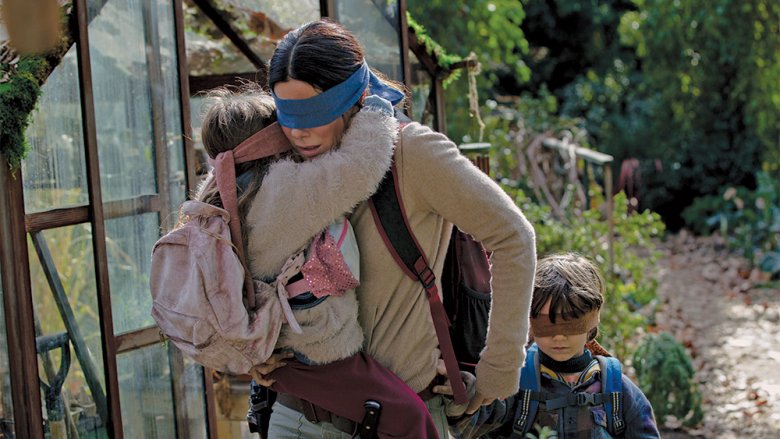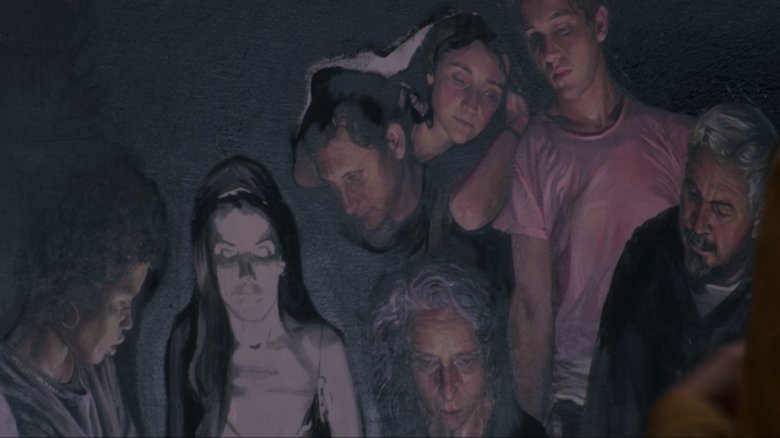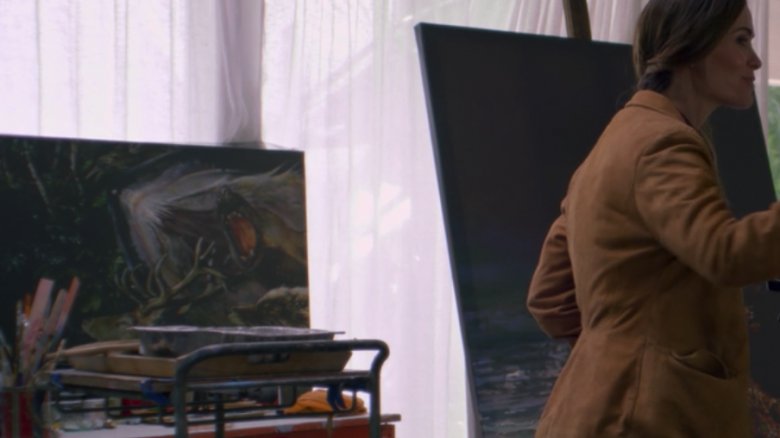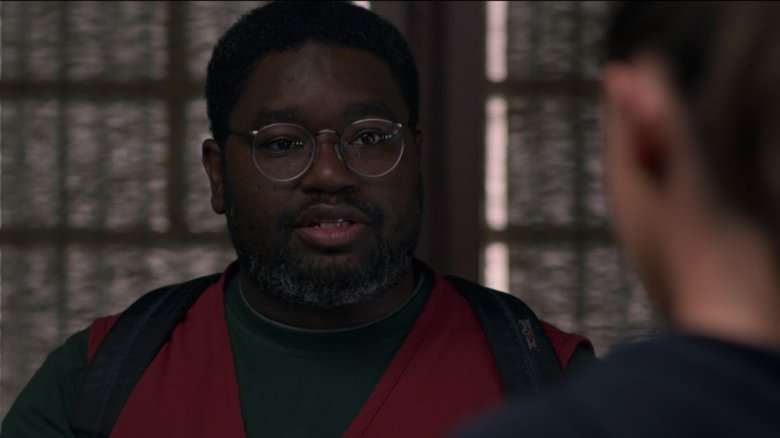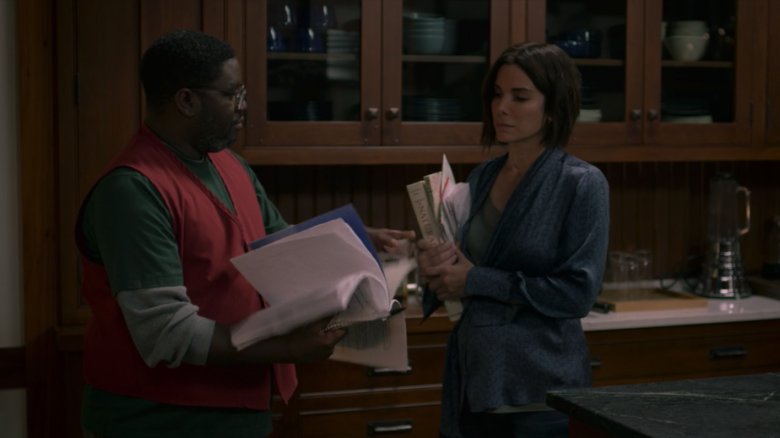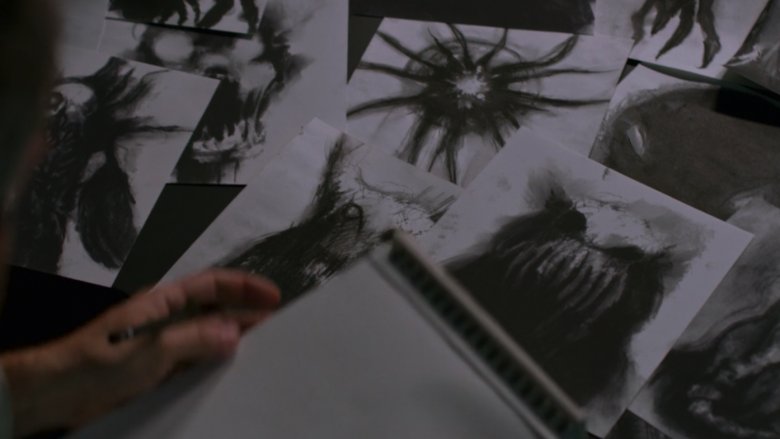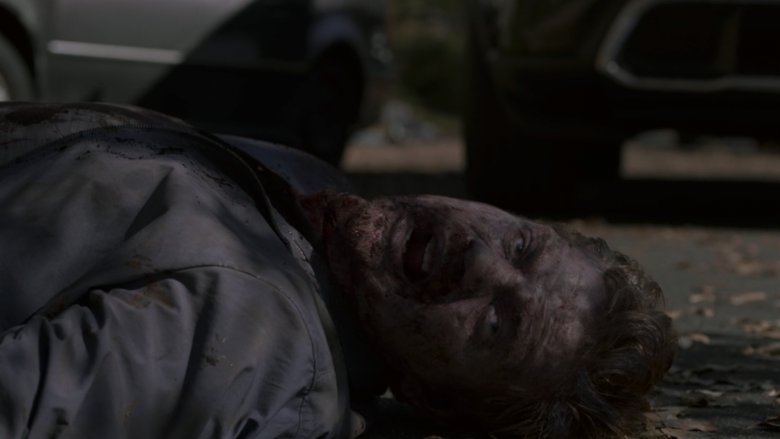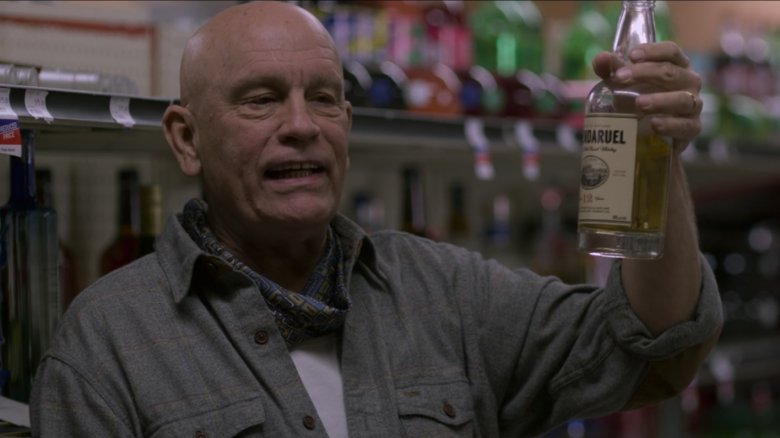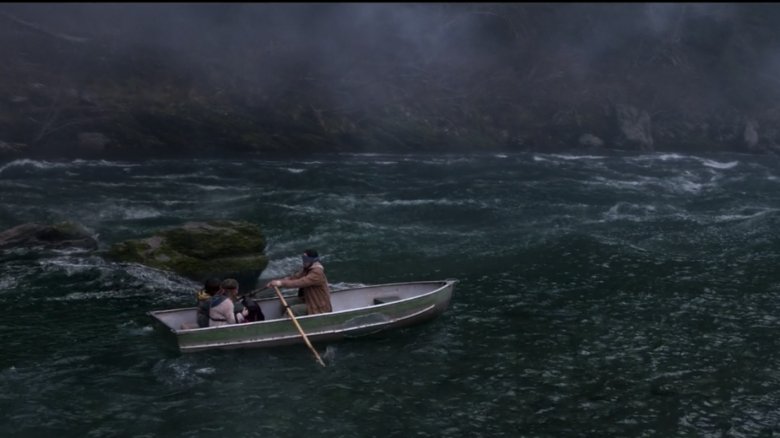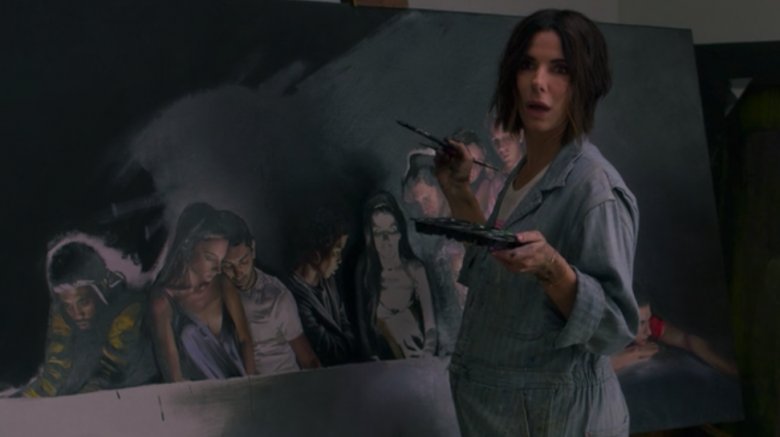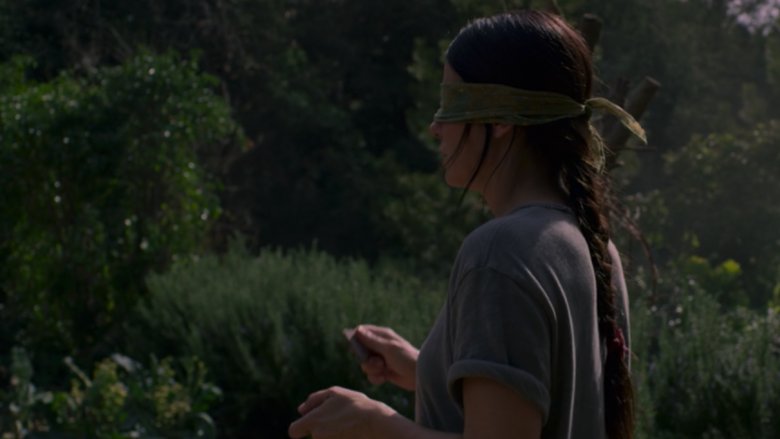Small Details You Missed In Bird Box
Whether you're a fan of a good thriller or not, chances are you've probably made the time to watch Bird Box. The Netflix original took the world by storm over the 2018 holiday season, and that momentum didn't slow down heading into 2019. The post-apocalyptic, suspense-laden film starring Sandra Bullock and adapted from the novel of the same name has been a smash hit, allegedly netting the streaming service their largest initial audience viewing to date.
As with most well-made movies, in many ways it's the little details throughout Bird Box that help elevate it from good to great, giving it a feeling of depth and authenticity. But the truth is, it's hard to catch all of the little subtleties and hints that are woven throughout the movie while you're busy trying not to fall off the edge of your seat as you strain for a glimpse of just what those monsters actually look like. We've gone ahead and gathered up some observations for you to mull over while you work through that post-credits daze. Here's a look at all the small details you missed in Bird Box.
The inability to connect
The first flashback in the film opens on Malorie's apartment, where her sister Jessica brings her groceries to restock her fridge. While we're still busy learning who Malorie and Jessica are, a bit of crucial yet quick commentary is snuck into the scene as the sisters discuss the painting Malorie is working on. The discussion reveals two completely different points: one regarding a deeper subtext for Malorie's character and another pertaining to society as a whole.
On the surface, Malorie explains that the painting is filled with people next to each other yet seemingly "unable to connect." This is important to keep in mind, as it's meant to reflect on Malorie's fear that she won't connect with her unborn child. It's a repeated theme that continues to play out as the film unfolds, and Malorie struggles to connect with the nameless Boy and Girl she's caring for. But in addition to the way the comment reflects on Malorie's character, it also can be seen as subtler commentary on the modern crisis of people unable to connect in a world filled with technology and social media.
Malorie's other paintings
That early scene in Malorie's apartment is actually a gold mine for little hints and teasers, and another comes in the form of one of her paintings located next to the larger piece she's actively working on. The secondary piece sports a number of elements that are eerily relatable to the events that are about to unfold. A deer can be seen being hunted down by a wolf while a ghoulish, unrecognizable form is seen to hover over the two creatures. Add to that the appearance of a bird above it all, and the whole piece seems to scream out with some kind of prophetic knowledge.
Malorie isn't necessarily anything more than a victim of the monsters that she later encounters, but it's interesting to note that she clearly isn't a stranger to thoughts of horrific supernatural scenarios. Coincidence? Perhaps. But on the other hand, it could also imply that she already had some inkling of the looming apocalypse before everything went down.
A monstrous rundown
About 15 minutes into the film, Malorie finds herself in unexpected company at Greg's house as the initial survivors take stock of their situation, lose cable, and are introduced to Douglas' endless stream of negative commentary. In the midst of the chaos, the seemingly gentle supermarket employee Charlie begins explaining how "humanity has been judged, and we're found wanting." When Felix brushes off the initial remarks as "religious talk," Charlie forcefully proceeds to explain how throughout history there have been many different "demons or spirit creatures" found in various world religions and mythologies, describing them as entities that take on forms of a person's greatest fears or losses.
It's easy to miss the details in the explanation during the flurry of events, but Charlie's exposition actually goes a long way toward explaining what these faceless villains are. He references ancient Zoroastrian religion, specifically calling out the Aka Manah or "Evil thought" along with the "Varios Daevas," multiple divinities that create and thrive in chaos. He also mentions Surgat, a particularly tough demon that appears in medieval manuscripts and is described as the one who "opens all locks." He also name-drops the Chinese shape-shifting terror of the Huli-jing as well as the transmogrifying goblin Puca from ancient Celtic mythology. All of these creatures have similar traits, and tend to revel in causing chaos and destruction.
Natural curiosities
While we're in the early phases of Malorie's forced stay in the house, let's take a quick look at one other tidbit that hints at her having more supernatural inclinations than may have been apparent at first glance. For starters, she's the one that picks up the story Charlie's been writing, showing a seemingly genuine curiosity towards something that has disgusted the rest of the group.
But her active interest in the creatures doesn't stop there. As she counts down the days during her long tenure in the house, Malorie is shown more than once wandering around holding multiple manuscripts, including a book of distressingly captivating mazes by Giovani Piranesi along with one titled Cabinet of Natural Curiosities, which takes a deep dive into many different strange and odd creatures, both real and mythical. Many of these have an eerie similarity to Gary's drawings later on in the film. Why is Malorie so interested in these creatures... and how is her sleuthing so spot on throughout the movie?
A little bit o' Love ...craft?
When Gary makes his big reveal as a servant of the creatures, it's prefaced with a brief, oddly cathartic scene when he lays out a series of drawings he's been working on, showing what is most likely his personal take on a large and varied assortment of the creatures. Interestingly, several of the drawings have distinct features that hint toward specific historical or fictional characters, including one of the most famous cosmic horrors in the history of literature: Cthulhu. The cephalopod head with its iconically subtle yet threatening overtones is immediately distinguishable.
The drawing is a wonderful shoutout to one of the founders of modern horror, Howard Phillips Lovecraft. Mr. Lovecraft was a master at crafting various forms of ultimate horror, often leaning largely on "the oldest and most powerful type of fear," fear of the unknown. While the "facelessness" of the Bird Box creatures can clearly find its inspiration in a number of classic horror characters, there's no doubt that Lovecraft's classics had a hand in at least part of the making of Bird Box, which is borne out by this honorary nod to one of the author's most infamous creations.
Closure
One of the more intriguing Easter eggs in the film comes early on — and is a little tough to catch. When Malorie first reaches the house after watching her sister willingly meet her demise, the initial chaos within the fledgling survivor community is tumultuous for a time. As the phones and cable begin to fail, though, one call manages to get through, leading to a heart-wrenching scene between two despairing parents and their child, who clearly sees one of the monsters while on the phone.
Rushing out the door without a thought for their own safety, the couple isn't seen again in the film... alive, that is. However, as the group heads out to gather supplies, they run over "speed bumps," one of which is the couple, lying in the street not far from the house. While their faces are hard to recognize, their clothes are the same, bringing some closure regarding their gruesome fate.
The high and mighty Douglas
While Sandra Bullock's character clearly steals the show, the film is enhanced by some stellar supporting actors, including John Malkovich, who plays the irritating "survive at any cost" Douglas. While Douglas' character was made up for the movie adaptation, that didn't make him expendable — in fact, he ends up playing a pretty crucial role in saving Malorie and the children's lives, despite being doubted, hit over the head, and locked in the garage.
But while Douglas does end up being the reluctant hero, another aspect of his character is harder to tolerate: he's never wrong. Everything he says — which is almost always predicting some sort of horrible fate — ends up happening. He's against his wife leaving the house, and she dies. He resists allowing Olympia in, and she ends up letting in Gary. He wants to kick Gary out regardless of his groveling desire to stay and ends up being locked in the garage while the possessed man betrays everyone else in the house. Heck, even the fact that he was initially suing his neighbor Greg for wanting to build a glass house was the right call. Imagine covering up that many windows with newspapers without getting a glimpse of the monsters. Fat chance.
Rowing
A fairly large portion of the movie takes place with Malorie, Boy, and Girl floating down the river. The trip takes over two days, and they come across a plethora of challenges as they go along, not the least of which is keeping the boat afloat, a feat Malorie manages to pull off until the rapids prove too much of a challenge. Making this even more impressive: the character is fairly new to rowing, only getting better as she goes along.
Bullock does a great job with this evolution of skill, as we see her initially flailing, whipping the oars around and trying to get her sea legs as she launches the boat. However, by the end, she's seen rowing with focus and determination, like an old pro. It turns out that this wasn't just acting: Bullock actually had no experience rowing when she stepped into the boat, purposefully leaning on her lack of know-how to help make the scene look more realistic. The river shots were filmed in order so her rowing would naturally improve as the movie progressed.
Nev Schulman
Ah, Malorie's paintings, the gift that just keeps on giving. One final fun little Easter egg hidden away in there comes in the form of MTV host Nev Schulman and his wife Laura. Shortly after the movie came out, he posted on Instagram that "#BirdBox was scary and all, but the creepiest part is how much the couple in Sandra Bullock's painting looks like me and Laura..." The resemblance is indeed remarkable, and it didn't take long to find out why.
A follow-up post cleared the air with a simple confession. "Ok ok. We actually know the artist (@lilyjmorris) who did the paintings for #BirdBox and posed for her." While not integral to the storyline or any of the characters, it's a nice touch, putting a bit of a fun spin on a more serious film, along with doubtless going a long way to help promote Morris' career.
Walking by faith
With all of the scares throughout Bird Box, it's easy to get very monster-centric in the discussion of what the film was actually about. But if one takes a step back and looks at the story as a whole, a few other themes start to jump out, including one big one that hides right in the open: walking by faith, not sight. The film is positively dripping with the common religious theme of relying on belief and not trusting what you can see.
We witness the characters trying to do their best without one of their most crucial senses, purposefully choosing not to look at their surroundings in order to survive. By doing so, they consciously forsake what would typically be the "common sense" solution but is, in this case, actually the most detrimental to their well-being. Whatever author Josh Malerman or director Susanne Bier may have meant to say through this is open to interpretation, but the parallel to trusting in faith rather than sight is as plain as the blindfolds that facilitate it throughout the film.
